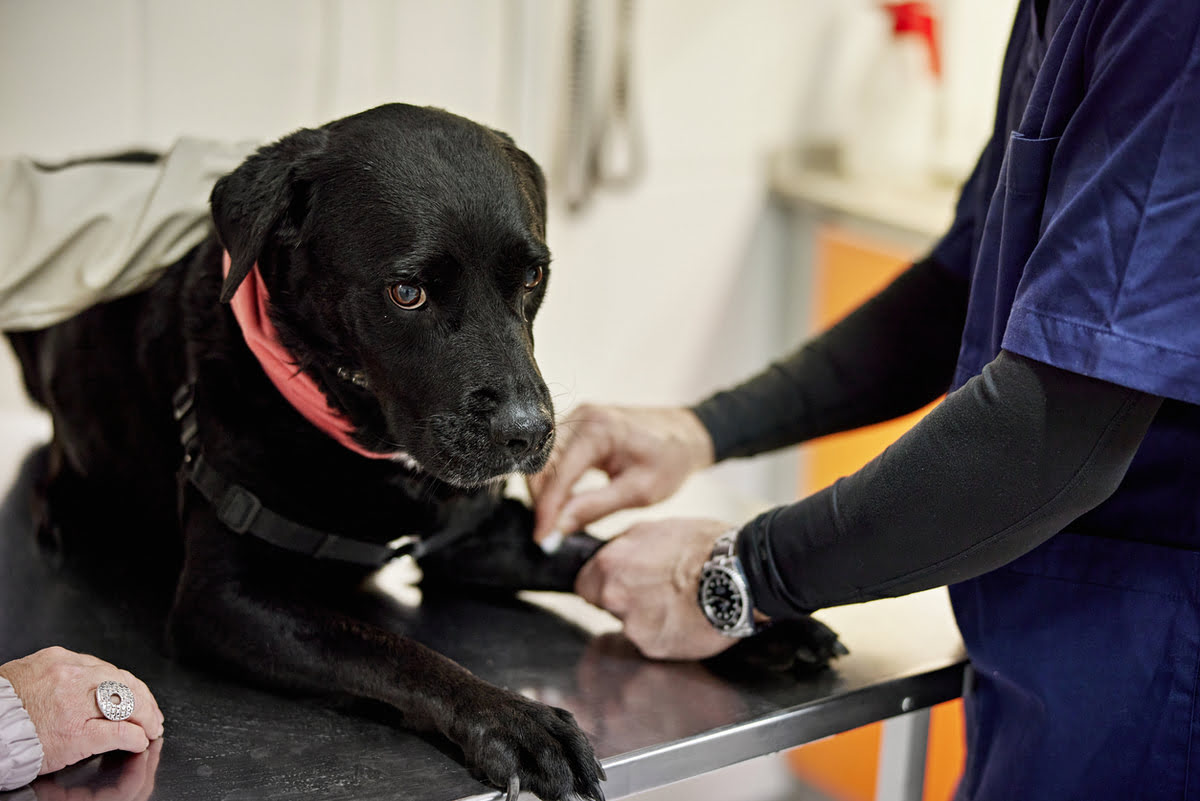Home>Health & Wellness>Common Health Issues>How To Live With A Dog When You Have Allergies


Common Health Issues
How To Live With A Dog When You Have Allergies
Published: January 26, 2024
Learn how to manage common health issues like allergies while living with a dog. Discover tips and strategies for a harmonious coexistence.
(Many of the links in this article redirect to a specific reviewed product. Your purchase of these products through affiliate links helps to generate commission for Pawsomeoldies.com, at no extra cost. Learn more)
Table of Contents
Introduction
Living with a dog can bring immense joy and companionship, but for those with allergies, it can also pose challenges. Allergies to dogs are a common concern, affecting approximately 10% of the population. The symptoms can range from mild discomfort to more severe reactions, making it essential for individuals with dog allergies to take proactive measures to manage their condition while enjoying the company of a furry friend.
In this comprehensive guide, we will explore practical strategies for living harmoniously with a dog when you have allergies. From understanding the root causes of dog allergies to selecting the most suitable dog breed and creating an allergy-friendly home environment, we will delve into the key considerations for mitigating allergic reactions. Additionally, we will discuss effective methods for managing allergy symptoms and provide valuable tips for maintaining a comfortable and fulfilling lifestyle alongside a beloved canine companion.
By gaining a deeper understanding of dog allergies and implementing the recommended strategies, individuals with allergies can experience the many benefits of canine companionship while minimizing the impact of allergic reactions. Whether you are a seasoned dog owner or considering bringing a dog into your home for the first time, this guide will equip you with the knowledge and tools to navigate the unique challenges of living with a dog when allergies are a concern.
Read more: Getting A Puppy When You Have A Senior Dog
Understanding Dog Allergies
Dog allergies are primarily triggered by exposure to proteins found in a dog's skin cells, saliva, and urine. These proteins, known as allergens, can elicit an immune system response in susceptible individuals, leading to a range of allergic symptoms. The primary allergen associated with dog allergies is a protein called Can f 1, which is produced in the sebaceous glands of the skin and is present in a dog's dander, or shed skin flakes. When a person with allergies comes into contact with these allergens, their immune system may perceive them as harmful invaders, prompting the release of histamines and other chemicals that lead to allergic reactions.
Common symptoms of dog allergies include sneezing, runny or stuffy nose, itchy or watery eyes, coughing, wheezing, and skin rashes. In more severe cases, individuals may experience asthma symptoms, such as difficulty breathing and chest tightness, particularly if they have underlying respiratory conditions.
It's important to note that dog allergies can vary in severity, with some individuals experiencing mild symptoms that are manageable, while others may face more significant challenges in coping with their allergic reactions. Additionally, the frequency and intensity of allergic symptoms can be influenced by factors such as the individual's sensitivity to allergens, the specific dog breed, and the level of exposure to allergens in the environment.
Understanding the underlying mechanisms of dog allergies is crucial for effectively managing and mitigating allergic reactions. By recognizing the sources of allergens and the potential triggers for symptoms, individuals can take proactive measures to minimize their exposure and create a more allergy-friendly living environment. Furthermore, gaining insight into the nature of dog allergies can inform the selection of dog breeds that are less likely to provoke allergic responses, thereby facilitating a more harmonious coexistence between individuals with allergies and their canine companions.
In the following sections, we will delve into practical strategies for choosing a dog breed that is compatible with allergies, creating an environment that reduces allergen exposure, and implementing measures to manage allergy symptoms effectively. By addressing these key aspects, individuals can navigate the complexities of dog allergies with greater confidence and enjoy the enriching experience of living with a dog while minimizing the impact of allergic reactions.
Choosing the Right Dog Breed
When considering bringing a dog into your home while managing allergies, selecting the right dog breed can significantly influence the likelihood of triggering allergic reactions. While no dog breed is entirely hypoallergenic, certain breeds are known to produce fewer allergens or shed less dander, making them more compatible with individuals prone to allergies.
One key consideration when choosing a dog breed is the type of coat they possess. Dogs with minimal shedding and a single-layered coat, such as poodles, bichon frises, and Portuguese water dogs, are often recommended for allergy sufferers. These breeds produce less dander and are less likely to spread allergens throughout the home, reducing the potential for allergic reactions.
Additionally, dogs with hair instead of fur, such as the Yorkshire terrier and the Maltese, are often favored by individuals with allergies due to their reduced shedding and dander distribution. Their hair-like coats minimize the dispersion of allergens, making them a suitable choice for those seeking a canine companion while managing allergies.
Furthermore, selecting a smaller dog breed can be advantageous for allergy sufferers, as smaller dogs generally produce fewer allergens and require less grooming, which can help minimize the spread of dander in the home environment. Breeds such as the Shih Tzu, the Havanese, and the Cavalier King Charles spaniel are known for their smaller size and potential compatibility with individuals prone to allergies.
It's important to note that individual dogs within the same breed can vary in their allergen production, so spending time with a specific dog before making a decision can provide valuable insight into the potential for allergic reactions. Additionally, regular grooming and bathing of the dog, along with frequent cleaning of their living spaces, can further reduce allergen levels and contribute to a more allergy-friendly environment.
By carefully considering the characteristics of different dog breeds and their potential impact on allergic reactions, individuals can make informed decisions when choosing a canine companion. While no breed guarantees complete immunity from allergic responses, selecting a breed that aligns with allergy management strategies can enhance the overall experience of living with a dog while minimizing the challenges associated with allergies.
Creating an Allergy-Friendly Home Environment
Creating an allergy-friendly home environment is essential for individuals with dog allergies, as it can significantly reduce the presence of allergens and minimize the risk of triggering allergic reactions. By implementing targeted strategies to mitigate allergen exposure within the home, allergy sufferers can create a more comfortable and manageable living space while enjoying the companionship of their canine pet.
One of the fundamental steps in establishing an allergy-friendly home environment is to designate specific areas for the dog, such as a well-ventilated room or a designated pet zone within the home. This approach helps contain allergens to particular areas, reducing their dispersion throughout the living space. Additionally, using high-efficiency particulate air (HEPA) filters in the designated pet areas can effectively capture airborne allergens, including pet dander and other microscopic particles, thereby improving air quality and minimizing allergic reactions.
Regular and thorough cleaning is paramount in maintaining an allergy-friendly home environment. Vacuuming carpets, rugs, and upholstery with a HEPA-filtered vacuum cleaner can help remove accumulated pet dander and hair, preventing the buildup of allergens. Hardwood or tile flooring is preferable to carpets, as it minimizes the retention of allergens and facilitates easier cleaning. Washing the dog's bedding and other fabric items regularly can also reduce allergen levels, contributing to a healthier indoor environment.
In addition to cleaning, minimizing the presence of dust and other potential allergens is crucial for allergy management. Using allergen-proof covers for mattresses, pillows, and upholstered furniture can create barriers against dust mites and pet dander, reducing the likelihood of allergic reactions. Regular dusting and cleaning of surfaces with damp cloths can further limit the accumulation of allergens, promoting a more allergy-friendly home environment.
Maintaining optimal humidity levels in the home can also play a significant role in managing allergens. Keeping indoor humidity between 30-50% can help prevent the proliferation of dust mites and mold, both of which can exacerbate allergic symptoms. Using dehumidifiers in damp areas and ensuring proper ventilation throughout the home can contribute to a more favorable environment for allergy sufferers.
By implementing these measures and incorporating other allergy-friendly practices, such as frequent washing of the dog, using hypoallergenic grooming products, and regularly replacing air filters, individuals can create a home environment that is conducive to managing dog allergies effectively. These proactive steps not only minimize allergen exposure but also contribute to a more comfortable and enjoyable coexistence with a beloved canine companion, enhancing the overall quality of life for individuals with dog allergies.
Managing Allergy Symptoms
Effectively managing allergy symptoms is crucial for individuals living with dog allergies. By implementing targeted strategies and utilizing appropriate medications and treatments, it is possible to alleviate allergic reactions and enhance overall well-being.
One of the primary approaches to managing allergy symptoms is the use of over-the-counter or prescription antihistamines. These medications work by blocking the action of histamines, which are responsible for triggering allergic responses such as sneezing, itching, and nasal congestion. Antihistamines can provide relief from these symptoms, allowing individuals to experience greater comfort and reduced discomfort when exposed to dog allergens.
In cases where nasal congestion and inflammation are prominent, nasal corticosteroids may be recommended to alleviate these symptoms. These medications help reduce swelling and inflammation in the nasal passages, providing relief from congestion and improving breathing. By targeting the underlying mechanisms of allergic reactions, nasal corticosteroids can effectively manage nasal symptoms associated with dog allergies.
For individuals with more severe allergic symptoms, including asthma exacerbations, allergen immunotherapy, commonly known as allergy shots, may be considered. This treatment involves administering gradually increasing doses of allergens to desensitize the immune system and reduce allergic responses over time. Allergy shots can be particularly beneficial for individuals with persistent and significant allergic reactions, offering long-term relief and improved tolerance to dog allergens.
In addition to medication-based approaches, environmental modifications can play a pivotal role in managing allergy symptoms. Using high-efficiency particulate air (HEPA) filters in the home can help capture airborne allergens, including pet dander, reducing their presence in the indoor environment. Regular cleaning and vacuuming, particularly with HEPA-filtered vacuum cleaners, can further minimize allergen accumulation and contribute to symptom management.
Furthermore, maintaining open communication with healthcare providers and allergists is essential for effectively managing allergy symptoms. By seeking professional guidance and adhering to personalized treatment plans, individuals can receive tailored recommendations and interventions to address their specific allergic concerns. This collaborative approach ensures that allergy symptoms are managed comprehensively, leading to improved quality of life and enhanced well-being for individuals with dog allergies.
By integrating these strategies and leveraging appropriate treatments, individuals can effectively manage allergy symptoms and minimize the impact of dog allergies on their daily lives. This proactive approach empowers individuals to enjoy the companionship of their canine pets while mitigating allergic reactions, fostering a harmonious and fulfilling relationship with their beloved dogs.
Tips for Living Comfortably with a Dog and Allergies
Living with a dog while managing allergies requires a thoughtful and proactive approach to ensure a comfortable and harmonious coexistence. By incorporating practical tips and lifestyle adjustments, individuals can navigate the challenges of dog allergies while enjoying the companionship of their canine pets.
-
Regular Grooming: Maintaining a consistent grooming routine for the dog is essential for minimizing allergen production and dander accumulation. Regular brushing and bathing can help reduce shedding and dander, thereby lowering the presence of allergens in the home environment.
-
Allergy-Friendly Dog Products: Utilizing hypoallergenic grooming products, including shampoos and conditioners specifically formulated for sensitive skin, can contribute to reducing allergen levels and promoting a healthier coat for the dog.
-
Outdoor Activities: Engaging in outdoor activities with the dog, such as walks and playtime in open spaces, can help minimize allergen exposure within the home. Fresh air and ample ventilation can contribute to a healthier indoor environment for individuals with allergies.
-
Designated Pet-Free Zones: Establishing specific areas within the home as pet-free zones, such as bedrooms and other personal spaces, can provide allergy sufferers with retreat areas that are less likely to contain allergens, allowing for respite from potential triggers.
-
Frequent Cleaning: Implementing a regular cleaning schedule for the home, including vacuuming, dusting, and laundering of fabric items, can help manage allergen levels and create a more allergy-friendly living environment.
-
Consultation with Allergists: Seeking guidance from allergists and healthcare providers can provide valuable insights and personalized recommendations for managing dog allergies effectively. Professional advice can inform tailored strategies for minimizing allergic reactions.
-
Healthy Lifestyle Practices: Maintaining overall health and wellness through proper nutrition, regular exercise, and adequate hydration can support the immune system and potentially mitigate the impact of allergic responses.
-
Open Communication: Establishing open communication with family members and household residents about the challenges of dog allergies can foster understanding and cooperation in maintaining an allergy-friendly home environment.
By integrating these tips into their daily routines and lifestyle practices, individuals with dog allergies can enhance their ability to live comfortably with a dog while effectively managing allergic reactions. These proactive measures empower individuals to experience the joys of canine companionship while minimizing the impact of allergies, fostering a fulfilling and enriching relationship with their beloved pets.














